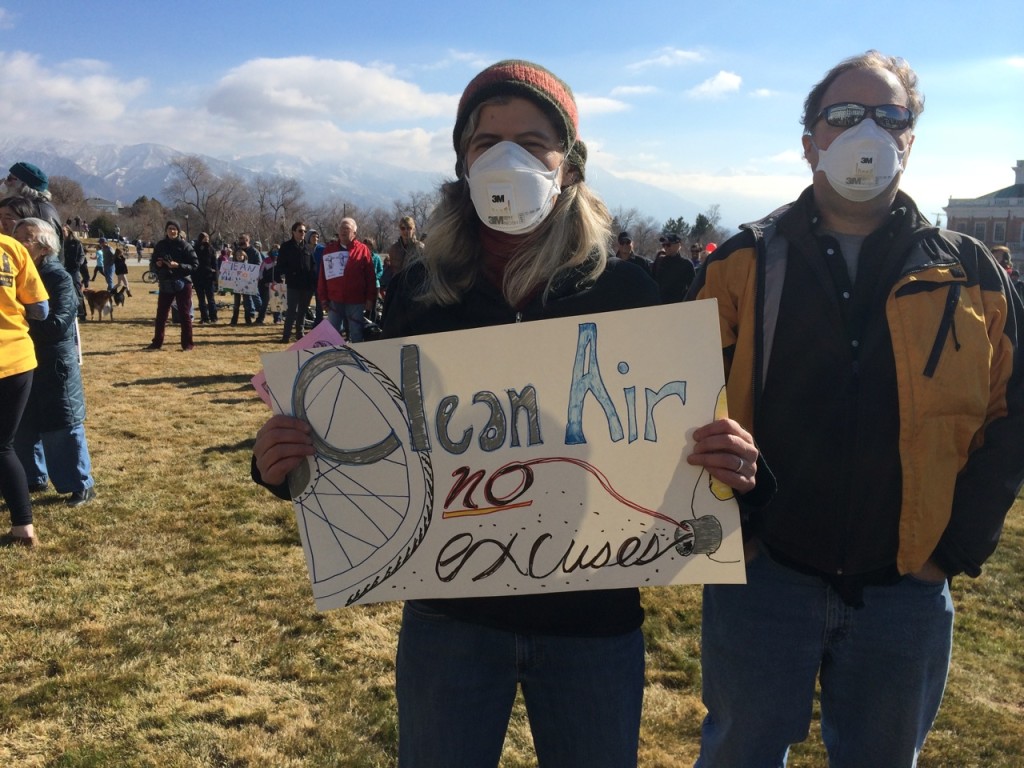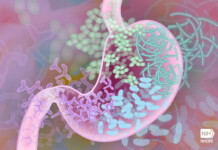 By Chaz Langelier, MD/PhD Student and Rita Sharshiner, Medical Student — At certain times of the year, Utah has some of the worst air quality in the nation. In fact, three of Utah’s major metropolitan areas are ranked in the top 25 cities most polluted by short-term air particle pollution (PM2.5), including Logan (5th), Salt Lake City-Ogden-Clearfield (7th), and Provo-Orem (19th).1 Poor air quality not only compromises the aesthetics of our beautiful state, it also significantly endangers the health of Utah’s citizens. Cyclists and other outdoor athletes breathe more air on a daily basis than the average Utah citizen, and thus riders exercising outside in Utah’s metropolitan areas face a unique and increased risk of air-pollution induced health problems. There are more than 2000 scientific studies published during the last decade that clearly show that levels of air pollution routinely found along the Wasatch Front lead to thousands of strokes, cases of heart disease, respiratory ailments and premature deaths each year.
By Chaz Langelier, MD/PhD Student and Rita Sharshiner, Medical Student — At certain times of the year, Utah has some of the worst air quality in the nation. In fact, three of Utah’s major metropolitan areas are ranked in the top 25 cities most polluted by short-term air particle pollution (PM2.5), including Logan (5th), Salt Lake City-Ogden-Clearfield (7th), and Provo-Orem (19th).1 Poor air quality not only compromises the aesthetics of our beautiful state, it also significantly endangers the health of Utah’s citizens. Cyclists and other outdoor athletes breathe more air on a daily basis than the average Utah citizen, and thus riders exercising outside in Utah’s metropolitan areas face a unique and increased risk of air-pollution induced health problems. There are more than 2000 scientific studies published during the last decade that clearly show that levels of air pollution routinely found along the Wasatch Front lead to thousands of strokes, cases of heart disease, respiratory ailments and premature deaths each year.
[Editor’s Note: This article was originally published on cyclingwest.com on 10-15-2007]
Air pollution is composed of a mixture of substances including fine particulate matter (particles <2.5µM in diameter or PM2.5), ozone, volatile organic compounds, nitrogen oxides, sulfur dioxide and toxic metals such as mercury. The combustion of fossil fuels, in particular coal, for electricity generation, is the single greatest source of air pollution in the United States. For extended periods throughout the past several years, the Wasatch Front and Cache Valley have experienced some of the unhealthiest air in the country and Salt Lake City is now poised to violate the EPA standards for two of the most harmful air pollutants, PM2.5 and ozone. Unhealthy ozone levels occur most frequently in Utah during the summer, while high particulate levels tend to occur during winter temperature inversion episodes.

Key Air Pollutants
From a public health standpoint, PM2.5 is one of the most significant air pollutants in our region. Numerous studies have shown a strong association between particle air pollution and early death, and it is estimated that 200,000 Americans die prematurely each year as a result of exposure to PM2.5.2-4 Long-term exposure to particle pollution results in increased hospitalization rates for asthma attacks, 5 impaired lung function and growth in children and teenagers, 6,7 significant damage to the small airways of the lungs,8 increased risk of dying from lung cancer and an increased risk of death from cardiovascular disease.10 Particle air pollution, like smoking, adversely affects the vasculature and circulation and has been shown to accelerate atherosclerosis.11 In animal models, particulate air pollution and a high-fat diet synergistically interact to raise cholesterol and accelerate atherosclerosis. 12
Ozone is a second key air pollutant responsible for significant health problems in Utah. While ozone high in the stratosphere is essential in protecting biological organisms from the damaging effects of UV radiation, tropospheric or “ground-level” ozone is quite harmful to human health. Ground-level ozone, the major constituent of summertime smog, is formed from a chemical reaction involving nitrogen oxides, volatile organic compounds and sunlight. This reaction is catalyzed by sunlight and as temperatures increase, so does ground-level ozone. Higher temperatures promote ozone formation and due to record heat in Utah this summer, there were an unprecedented number of days during which Wasatch Front communities experienced unhealthy levels of ozone air pollution. New research has confirmed that ozone exposure increases the risk of premature death13 and well established studies have found that acute effects of exposure include shortness of breath, chest pain, wheezing, coughing, and increased susceptibility to respiratory infections. Animal toxicology studies have also shown that long-term exposure to high levels of ozone induces permanent structural changes to the lungs.14
Protecting Your Health
The combined impact of air pollution on public health in both Utah and throughout the world is exceedingly significant. Studies estimate that the nationwide death toll attributed to air pollution exceeds tens of thousands annually15 and considerable evidence now demonstrates that there exists no safe level of exposure for either PM2.5 or ozone.9, 10, 16 Because respiratory rate increases significantly during exercise, cyclists riding outside in Utah’s urban areas receive a greater dose of air pollution compared to the general population. In addition, riding on or next to a busy roadway exposes the rider to significant particulate air pollution. Fortunately, there are a number of techniques that Utah cyclists can utilize to minimize exposure. Throughout the year, on high pollution days, it may be best to cycle indoors on a stationary bicycle or exercise outside above the inversion in the mountains. In fact, it may do more harm than good to exercise outside during high pollution days, especially if an intense workout is planned. During the summer, it is safest to cycle during early morning hours before sunlight and high temperatures induce ozone formation. During winter inversions, exercising inside or in the mountains above the level of inversion is best.
Given the overwhelming evidence demonstrating the adverse health effects of air pollution, it is without question that it is in the best interest of cyclists and other athletes in Utah to be aware of daily pollution levels and air quality forecasts. Reliable current and forecasted air pollution levels throughout Utah are available from several sources, including the Utah Division of Air Quality at www.airquality.utah.gov and the US EPA at airnow.gov and can also be obtained via local radio, television and newspapers. Unfortunately, there are a number of looming threats to air quality along the Wasatch front, including a continually increasing number of vehicles on the road each year and a lack of adequate funding for public transit infrastructure. In addition, multiple refineries in North Salt Lake have submitted proposals to expand. There are also plans to build four new coal-fired power plants upwind in Nevada and two new coal power plants each year for the next several years in Utah. Fortunately, as citizens, we have the power to elicit change and avert future threats to Utah’s air quality through grass roots activism. In fact, several medical and public interest organizations who readily welcome volunteers are currently engaged in advocating for more protective State and Federal air pollution legislation including Utah Physicians for a Healthy Environment (http://www.uphe.org), Utah Mom’s for Clean Air (http://utahmomsforcleanair.org) the American Lung Association (http://www.lungusa.org), and the Utah Chapter of the Sierra Club (http://utah.sierraclub.org).
References
- American Lung Association. State of the Air Report 2006. At http://www.ALA.org.
- Pope CA, Burnett RT, et al. Lung cancer, cardiopulmonary mortality, and long-term exposure to fine particulate air pollution. JAMA. 2002; 287(9): 1132-41.
- Dockery DW, Pope CA et al. An association between air pollution and mortality in six U.S. cities. The New England Journal of Medicine. 1993; 329(24): 1753-9.
- Hoek G, Brunekreef B, et al. Association between mortality and indicators of traffic-related air pollution in the Netherlands: a cohort study. Lancet. 2002;360(9341):1203-9.
- Lin S, Munsie JP, Hwang SA, Fitzerald E, Cayo MR. Childhood Asthma Hospitalization and Residential Exposure to State Route Traffic. Environ Res 2002; 88:73-81.
- Gauderman WJ, Gilliland GF, Vora H, Avol E, Stram D, McConnell R, Thomas D, Lurmann F, Margolis HG, Rappaport EB, Berhane K, Peters JM. Association between Air Pollution and Lung Function Growth in Southern California Children: results from a second cohort. Am J Respir Crit Care Med 2002;166:76-84.
- Gauderman WJ, Avol E, Gilliland F, Vora H, Thomas D, Berhane K, McConnell R, Kuenzli N, Lurmann F, Rappaport E, Margolis H, Bates D, Peters J. The effect of air pollution on lung development from 10 to 18 years of age. NEJM 2004;351:1057-67
- Churg, A Brauer, M, Avila-Casado, MdC, Fortoul TI, Wright JL. Chronic Exposure to High Levels of Particulate Air Pollution and Small Airway Remodeling. Environ Health Perspect 2003; 111: 714-718.
- Pope CA, Burnett RT, Thun MJ, Calle EE, Krewski D, Ito K, Thurston GD. Lung Cancer, Cardiopulmonary Mortality, and Long-Term Exposure to Fine Particulate Air Pollution, JAMA 2002;287:9.
- Pope CA III, Burnett RT, Thurston GD, Thun MJ, Calle EE, Krewski D, Godleski JJ. Cardiovascular Mortality and Year-round Exposure to Particulate Air Pollution: epidemiological evidence of general pathophysiological pathways of disease. Circulation. 2004; 109:71-77.
- Kunzli N, Jerrett M, Mack WJ, et al. Ambient air pollution and atherosclerosis in Los Angeles. Environ Health Perspect 2005;113:201-206. [ISI][Medline]
- Sun Q et al. Long term air pollution exposure and acceleration of atherosclerosis and vascular inflammation in the animal model. JAMA. Dec. 21, 2005, Vol. 294: p 3003–10.
- Bell ML, Dominici F, and Samet JM. A Meta-Analysis of Time-Series Studies of Ozone and Mortality with Comparison to the National Morbidity, Mortality, and Air Pollution Study. Epidemiology 2005; 16:436-445. Levy JI, Chermerynski SM, Sarnat JA. Ozone Exposure and Mortality: an empiric Bayes metaregression analysis. Epidemiology 2005; 16:458-468. Ito K, De Leon SF, Lippmann M. Associations Between Ozone and Daily Mortality: analysis and meta-analysis. Epidemiology 2005; 16:446-429.
- Fanucchi MV, Plopper CG, Evans MJ, Hyde DM, Van Winkle LS, Gershwin LJ, Schelegle ES. Cyclic Exposure to Ozone Alters Distal Airway Development in Infant Rhesus Monkeys. Am J Physiol Lung Cell Mol Physiol 2006; 291:644-650.
- Abt Associates. The Particulate-Related Health Benefits of Reducing Power Plant Emissions. October 2000. Available at http://www.catf.us/publications/view/4. ; U. S. Environmental Protection Agency. Fact Sheet: Clean Air Interstate Rule, March 10 2005. Available at http://www.epa.gov/air/interstateairquality/pdfs/cair_final_fact.pdf.
- Pope A et al. Ischemic heart disease triggered by short – term exposure to fine particulate air pollution. Circulation. 2006 (114): 2443–2448.





Good report, thanks. I’ve developeed asthma over the last 5 years from riding in the lower SLC valley. Escaping to St. George and Summit County in the winter is great.
[…] In winter, PM 2.5 (2.5 micron diameter particulate matter) abounds in our air. PM 2.5 lodges in our lungs and can lead to asthma, impaired lung function, and increased risk for lung cancer. For a longer explanation of the effects of PM 2.5 and ozone, with references, see https://www.cyclingwest.com/fitness/health/air-quality-and-cycling-what-utah-riders-need-to-know/ […]
I appreciate your well written and data driven article. Additionally, your suggestions to deal with bad air days is also helpful. Thanks.
Comments are closed.